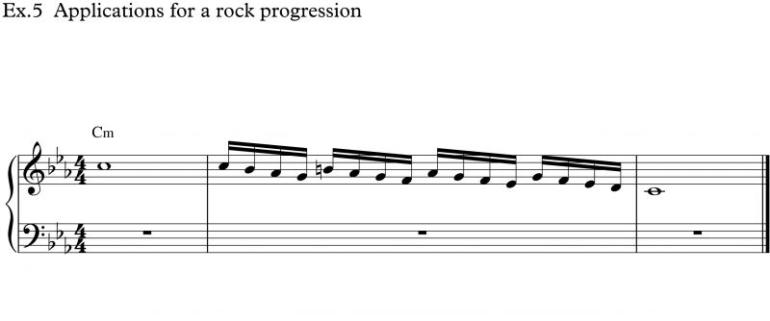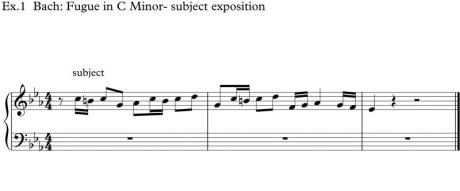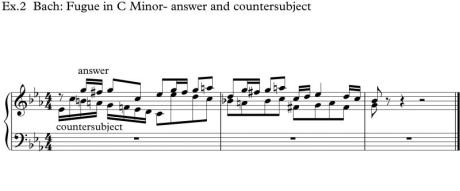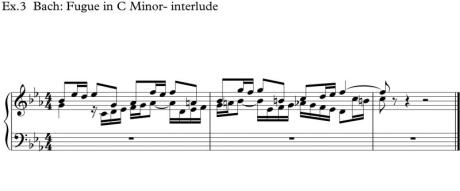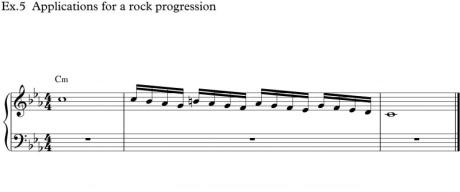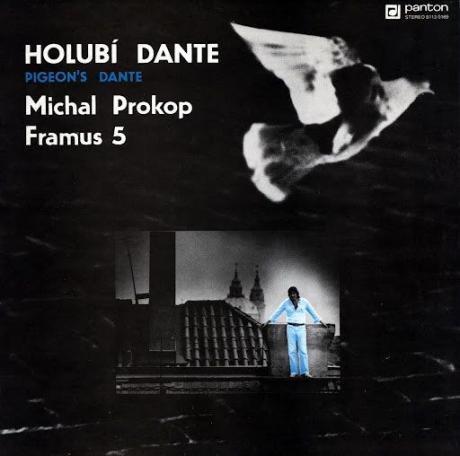Rock Organ XIII. - workshop

Čtenáři, možná vás zaskočí, že na českých stránkách nacházíte anglický text. Není to chyba. V současné době pro časopis Muzikus píše newyorkský klávesista a pianista Brian Charette. A tak jsem si v redakci řekli, že bychom mohli něco udělat pro zlepšení vašich znalostí angličtiny. Určitě nám dáte za pravdu, že angličtina se na pódiích objevuje stále častěji a potřeba domluvit se na pódiu i v zákulisí se stane brzy samozřejmosti. Proto zde naleznete originální verzi přímo od Briana a na stránkách časopisu Muzikus v čísle 11/2013 článek přeložený Petrem Štikou. Navíc zde máte audio ukázky, které do časopisu jaksi přeložit neumíme. Enjoy reading!
šéfredaktor časopisu Muzikus Ing. Vladimír Švanda
This month I would like to talk about Baroque composer, JohannSebastian Bach (1685-1750) and how important his contribution to melody,theory, and form was. It's nearly impossible to hear music in any genre that isnot in some way influenced by him. Let's backtrack for a second to see whatJ.S.B was up to, and I'll show you how to use his valuable techniques to addspice to your riffs and solos.

Two of Bach's volumes have special significance; Well TemperedClavier Books 1 and 2. Meant to be a training device for keyboard students,the first collection was compiled in 1722 and the second followed 20 yearslater in 1742. Each set contains twenty-four pairs of preludes and fugues inall 12 keys. The music was monumentally important for a few reasons. First, thepieces espoused a system of tuning called Equal Temperament that made all ofthe keys sound similar to each other. Older systems of the day, like the MeanTuning, sounded great in a few keys but sounded very out of tune as sharps andflats were added. Well Temperament evens all the keys out and remains to thisday the system that 98% of Western music is written in. Well TemperedClavier provided the blue print for melodic and harmonic invention for allWestern music that came after. The pieces are also considered to be thepinnacle of a musical form called fugue where a melodic subject is manipulatedto form the basis of an entire piece. It's specifically this process that wewill investigate.
Ex. 1
Lets take a look at the first two bars from the C Minor Fuguein Well Tempered Fugue Book 1. The fugue starts with an exposition of amelody called the subject. Notice that our subject is in the C harmonic MinorScale (C, D, Eb, F, G, Ab, B, C). Within the line there is a small idea ormotif that keeps reappearing throughout the whole piece; the C, B, C of beats 1and 3+. Melodies of Bach are incredible examples of balance and economy. Theline never goes too high or too low and aways has a few nice motifs that repeatand appear in other areas of the fugue. The term fugue literally means "toflee". The melodies chasing and answering each other while filling in theharmony as they pass each other is the defining sound of a fugue.
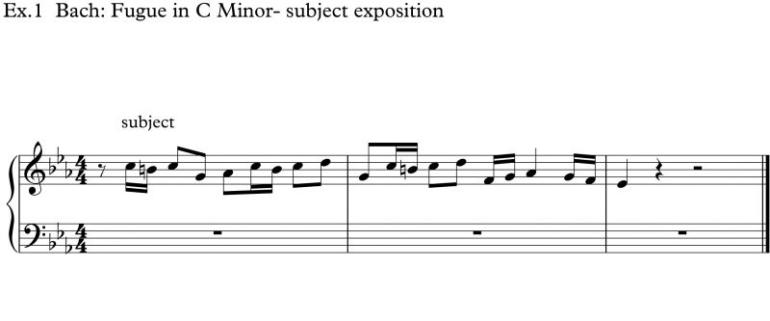
Ex. 2
As the piece continues in Bars 3-6, an answer (basically thesubject a 5th higher) occurs in the soprano voice as the middle voice forms anaccompaniment called the counter subject. The counter subject has new melodicmaterial and is meant to accompany the subject. The counter subject's job is toharmonize the answer with scales that gently change direction and fill out theharmony. The tonality also switches to G by the end of the answer phrase.During a fugue, the tonality and rhythm will often modulate slightly forrhythmic and harmonic interest. Bach could improvise fugues in any key with upto six voices and while adhering to very strict composition rules. If he wasalive today, who knows how his improvisations would sound! One thing is forsure: he is the grandmaster of our Western European harmonic system and is veryimportant for modern musicians in every genre.
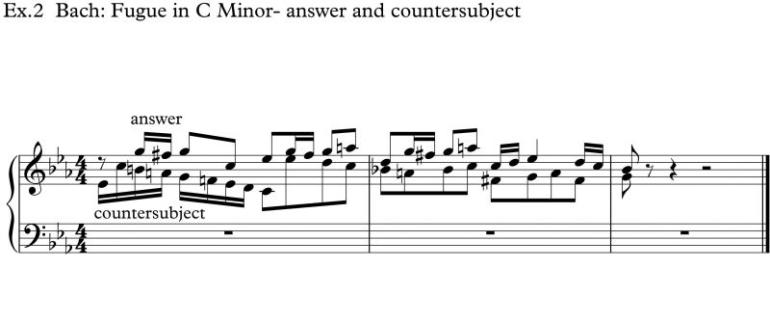
Ex. 3
In Bars 5-6 we have a short interlude that is comprised ofmaterial from the subject and counter subject. Notice how that first C, B, C"riff" we talked about in Ex. 1 is manipulated to fit the differentharmony that moves up by step. The accompaniment follows the shape of thecounter subject and fills in important notes with scales that paint theharmony. The key centers move every beat from Eb, Fm, Gm, Ab.
There are a few more concepts about fugue, like episodes, that wedon't have a lot of time to go into here. I suggest you do some study of fugueon your own. Check out the book The Study of Fugue by Alfred Mann. Forour purposes now, lets take the little bit we've learned and see how we canintellectualize our brutal rock solos :)
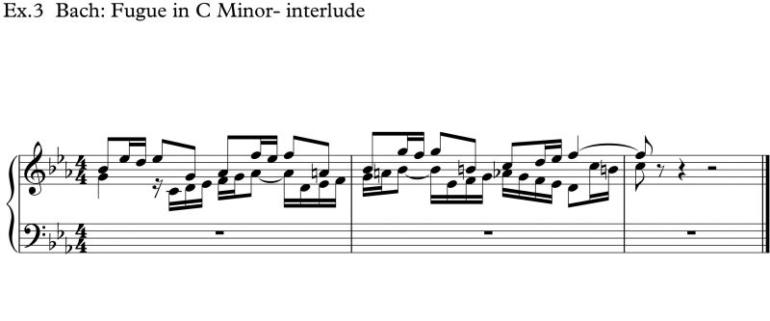
Ex. 4
We are lucky that we live a few hundred years after J.S.B, becausewe now have no strict rules about what we can do in music! Look at Ex. 4.In the middle of a burning solo, I'll sometimes backtrack 400 years and playsomething like this. I've taken the shapes and rhythms from our previousexamples and come up with a "rock fugue". We stay mostly in the CDorian mode here (C, D, Eb, F, G, A, Bb, C). I keep our motif from Ex 1. andimprovise a lower line in the style of Bach's counter subject with my lefthand. When you first try this stuff, just go for it and don't worry so muchabout accuracy.
I highly suggest learning all the Preludes and Fugues from bothBach volumes. It will revolutionize your playing and you will start to thinklike he does. You will also become an amazing sight reader because of all thekeys.
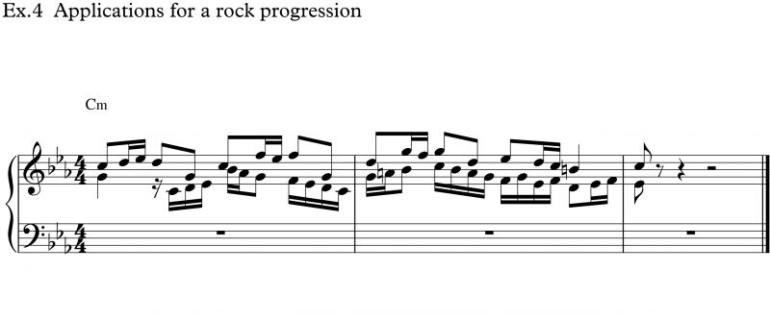
Ex. 5
Here's a simplified one handed line on a faster tempo. We are inthe C Harmonic Minor Scale here (C, D, Eb, F, G, Ab, B, C) just like in thebeginning of Bach's fugue. In this example, we take a simple four note motiffrom the scale and just move it down by step until the tonic note. Jon Lord ofDeep Purple plays a line like this in Highway Star. Jon was super intoclassical music. Check out the album Machine Head by Deep Purple. Ithink that album is a great resource for what we've been speaking about here.Watch what happens when you whip this stuff out a few times on a gig, yourfriends will flip!
